
| What is Flavor and Fortune? |
| How do I subscribe? |
| How do I get past issues? |
| How do I advertise? |
| How do I contact the editor? |
Read 13054021 times
Connect me to:
| Home |
| Articles |
| Book reviews |
| Letters to the Editor |
| Newmans News and Notes |
| Recipes |
| Restaurant reviews |
| Article Index (all years, slow) |
| List of Article Years |
| Article Index (2025) |
| Article Index (last 2 years) |
| Things others say |
| Related Links |
| Log In... |
| Authors |
| Categories & Topics |
Dumplings: Holiday, History, and Happiness--Part II
| by Jacqueline M. Newman |
Dim Sum and Other Snack Foods
Fall Volume: 2008 Issue: 15(3) page(s): 29, 30, 33, 35, 36, and 37
In the previous issue, Part I of this article in Volume 15(2) on pages 11, 12, and 13, it ended talking about New Year dumplings. Other Chinese holidays also have special dumplings. For example, during Dragon Boat Festival on the fifth day of the fifth lunar month, dumplings can be shaped like big moons called zong zi. They and some recipes were included in Volume 8(3) on pages 5 and 8. Most often wrapped in bamboo, reed, or other large leaves, their shapes and fillings do vary. Some exteriors are multi-layered, one is inside the leaf wrapping, another of glutinous rice, is inside that one. Sometimes there are other fillings within these layers, other times inside both of them.
For the Mid-Autumn Festival, dumplings are usually bigger. These are called tangyuan or moon cakes. Not everyone thinks of them as a dumpling, but they are stuffed, often with two exterior layers. In different regions and among different minority populations, they were made in special ways. These and zongzi are rarely, if ever, eaten as a meal, but rather as between meals snacks. Check out this magazine's index listing to locate articles and recipes for these holidays. Also check recipe listings for other dumplings.
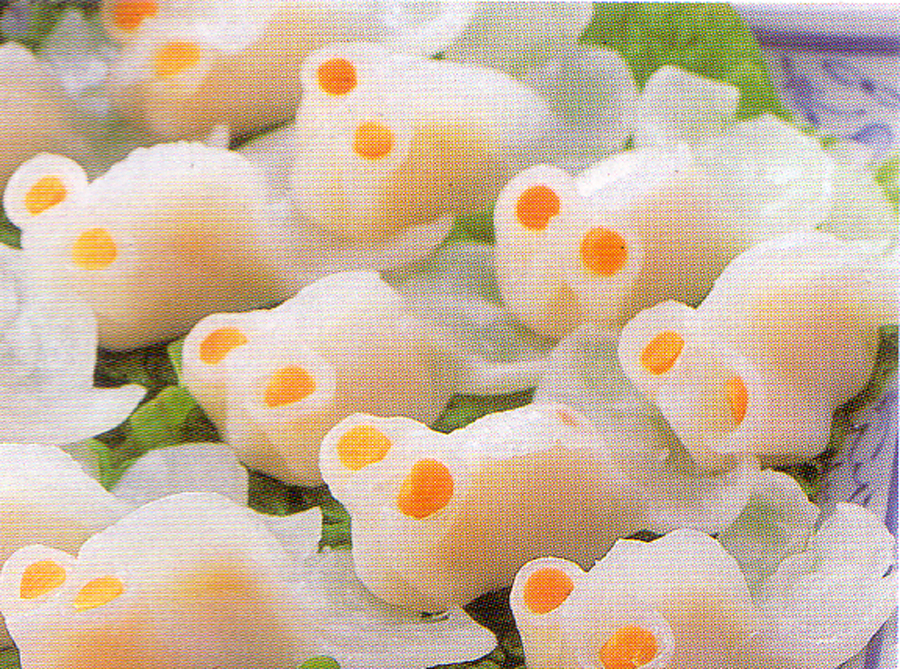 General stories and festivities aside, types of dumplings, their fillings, and the places they are made fascinate. For example, har gao, which in English translates to 'shrimp dumplings' are famous and fantastic. Their origin is reportedly in Guangzhou, and differences in their fillings are legion. There can be lots or little shrimp, they can be minced or ground, chopped in large pieces, or left whole. No matter their texture, other foods can be added, the most common are minced water chestnuts. Unlabeled, these and other dumplings are illustrated in this article, can you tell which is which?
General stories and festivities aside, types of dumplings, their fillings, and the places they are made fascinate. For example, har gao, which in English translates to 'shrimp dumplings' are famous and fantastic. Their origin is reportedly in Guangzhou, and differences in their fillings are legion. There can be lots or little shrimp, they can be minced or ground, chopped in large pieces, or left whole. No matter their texture, other foods can be added, the most common are minced water chestnuts. Unlabeled, these and other dumplings are illustrated in this article, can you tell which is which?
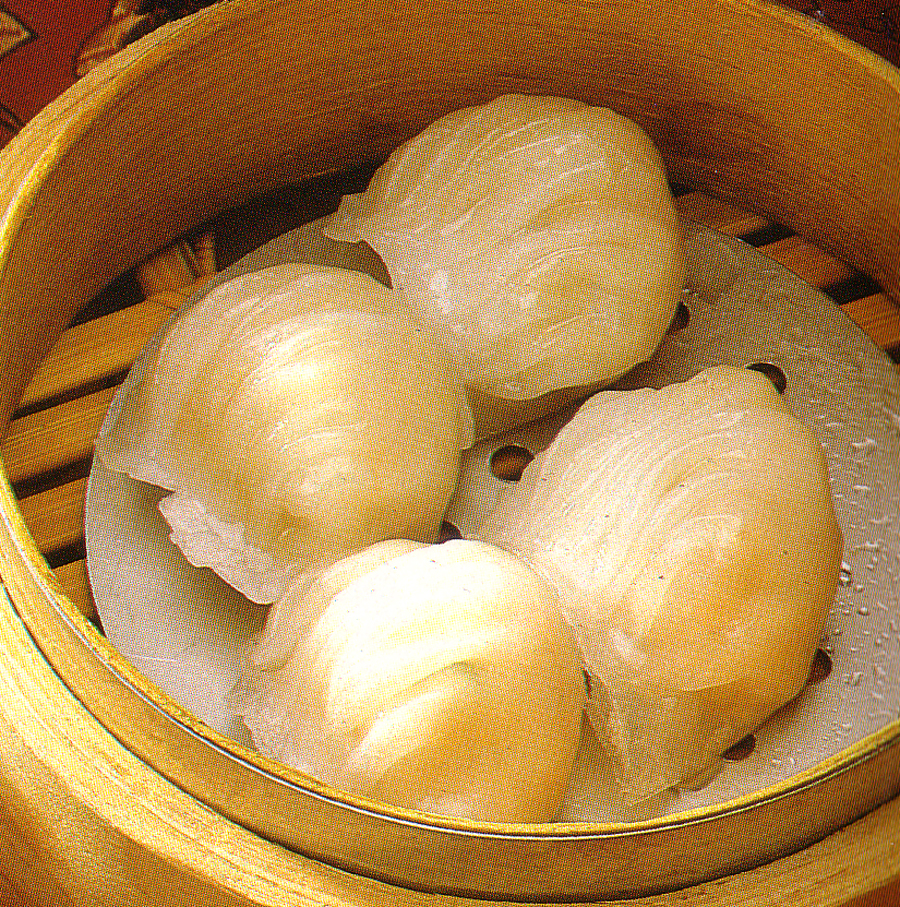 Another question, when you make the siu mai in this article, can you taste differences between it and the one in Volume 15(2) on page 12? One southern chef told us he judges his culinary compatriots by tasting their har gao. When he finds the dough thick and pasty, and the shrimp not sweet, he gets up, pays promptly, and points himself towards another dim sum emporia. Sometimes he evaluates dim sum chefs tasting their fried taro dumplings. Before so doing, he puts one of them on his napkin checking it in a few minutes for an oil ring. He believes no properly fried food should stain a napkin.
Another question, when you make the siu mai in this article, can you taste differences between it and the one in Volume 15(2) on page 12? One southern chef told us he judges his culinary compatriots by tasting their har gao. When he finds the dough thick and pasty, and the shrimp not sweet, he gets up, pays promptly, and points himself towards another dim sum emporia. Sometimes he evaluates dim sum chefs tasting their fried taro dumplings. Before so doing, he puts one of them on his napkin checking it in a few minutes for an oil ring. He believes no properly fried food should stain a napkin.
In Shanghai, xia long bao or soup dumplings are popular and savory. This same chef calls them his culinary Shanghai barometer. Chefs in the know, he says, make theirs tender and filled with minced pork with or without crab meat. He likes his with and spurting hot soup on the very first bite. He bristles when in the United States. Here, in this country, for safety's sake almost all of them come swimming in a bowl of soup, not in a steamer basket. He wonders why Americans do not know to put a soup dumpling on a Chinese soup spoon with its garlic-laden-soy sauce? Can't they bite gently into a soup dumpling, he asks, and not be scalded by the soup in these dumplings?
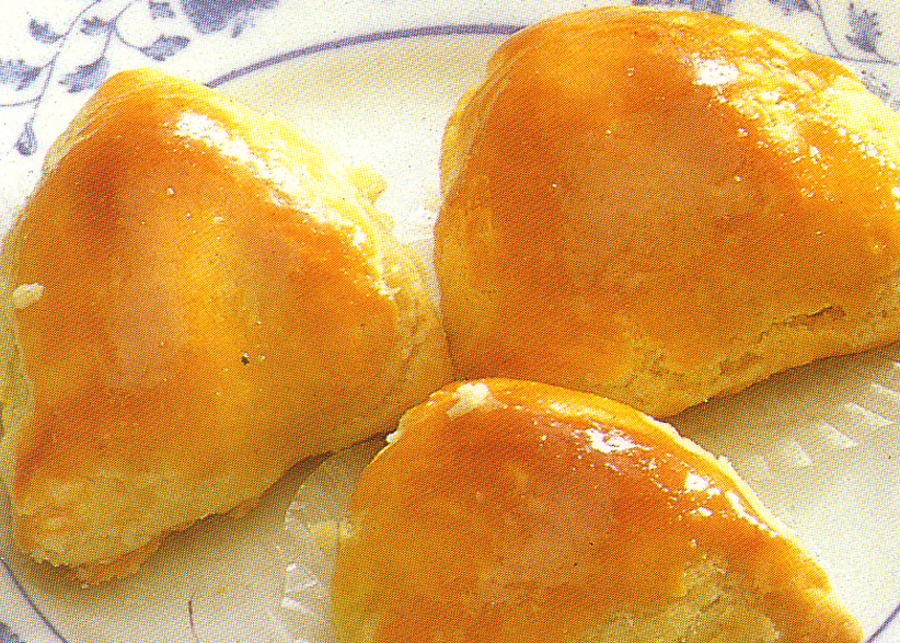 In Dongbei, China's East-North region of three provinces sandwiched between Russia and Korea, and in the Shandong province, dumplings are large, chewy, and filled with leeks, lamb or another meat, and often mixed with pickled cabbage. Some come filled with pumpkin and other vegetables. He wonders why customers complain that they do not look pretty. He once tried to explain that China's northeast is, weather-wise, a tough place that cares not about looks but does care about taste.
In Dongbei, China's East-North region of three provinces sandwiched between Russia and Korea, and in the Shandong province, dumplings are large, chewy, and filled with leeks, lamb or another meat, and often mixed with pickled cabbage. Some come filled with pumpkin and other vegetables. He wonders why customers complain that they do not look pretty. He once tried to explain that China's northeast is, weather-wise, a tough place that cares not about looks but does care about taste.
In the north, dim sum is called dian xin. There, rarely do dumplings look as delicate as they do in the south. In Dongbei, he said, the very cold winter and Russian influences reflect that. He continued to advise that dumplings and other foods often taste of pickles known to the Koreans as kimchi. They often have cabbage and/or another pickled filling within. These people in the north like their foods simple and satisfying, which is, he said, "more important than being beautiful."
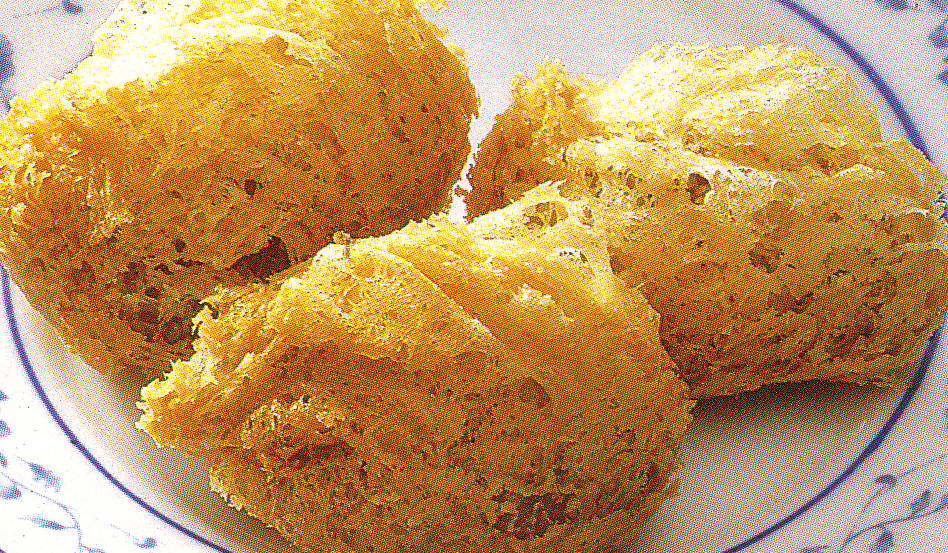 In Xian, the birthplace of northern-style dumplings, there are many, many kinds made in many sizes and with many fillings and many exteriors. There are many ways to prepare them, but steamed is preferred. We once ate in a dumpling restaurant in that city that made more than a hundred different kinds on any given day. We had a dumpling banquet that began with a very big dumpling large enough to fill the plate. Our notes indicate this dumpling meal included forty-six different dumplings, and after that huge one, each was smaller than the previous, the very last course was not one but many dumplings, each about the size of a small nail on one's smallest finger. These finales came in a bowl, twenty tiny white ones swimming in sweet soup.
In Xian, the birthplace of northern-style dumplings, there are many, many kinds made in many sizes and with many fillings and many exteriors. There are many ways to prepare them, but steamed is preferred. We once ate in a dumpling restaurant in that city that made more than a hundred different kinds on any given day. We had a dumpling banquet that began with a very big dumpling large enough to fill the plate. Our notes indicate this dumpling meal included forty-six different dumplings, and after that huge one, each was smaller than the previous, the very last course was not one but many dumplings, each about the size of a small nail on one's smallest finger. These finales came in a bowl, twenty tiny white ones swimming in sweet soup.
In Hong Kong, we found local dumplings wrapped in a lightly tinged yellow dough that were fine and fantastic. They were often filled with crab or another high-priced ingredient. Some were with lots, others with but a little amount of shark's fins, bird's nests, hair seaweed, etc. Dumplings in that city can be loaded with prestige, their expensive contents sticking out for everyone's viewing.
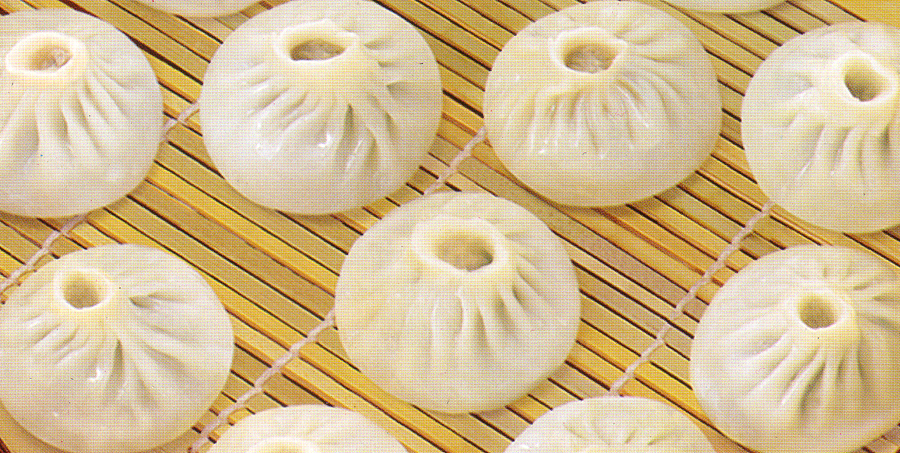 In Suzhou, at the Pine and Crane Tower Restaurant, in the 1980's we ate a first course never to be forgotten. On one plate and for the ten of us at one table were ten different fruit and vegetable dumplings worthy of a featured spot in a museum. Each one was colored, steamed, filled with the food it resembled, and looking like that fruit or vegetable miniaturized. Each was loaded with taste and looked and tasted like the real thing. Pity was that each of us only had one of these two inch beauties. I was lucky, my husband and I shared.
In Suzhou, at the Pine and Crane Tower Restaurant, in the 1980's we ate a first course never to be forgotten. On one plate and for the ten of us at one table were ten different fruit and vegetable dumplings worthy of a featured spot in a museum. Each one was colored, steamed, filled with the food it resembled, and looking like that fruit or vegetable miniaturized. Each was loaded with taste and looked and tasted like the real thing. Pity was that each of us only had one of these two inch beauties. I was lucky, my husband and I shared.
These days, at banquets or back-alley snack shops, rarely are dumplings fancy, rarely that unusual, often even not that good. While they come with all kinds of interiors and exteriors, most people do not know to eat slowly savoring every bite. We watch folk devouring them all-too-quickly, good, bad, or in-between; do they even know what they are tasting?
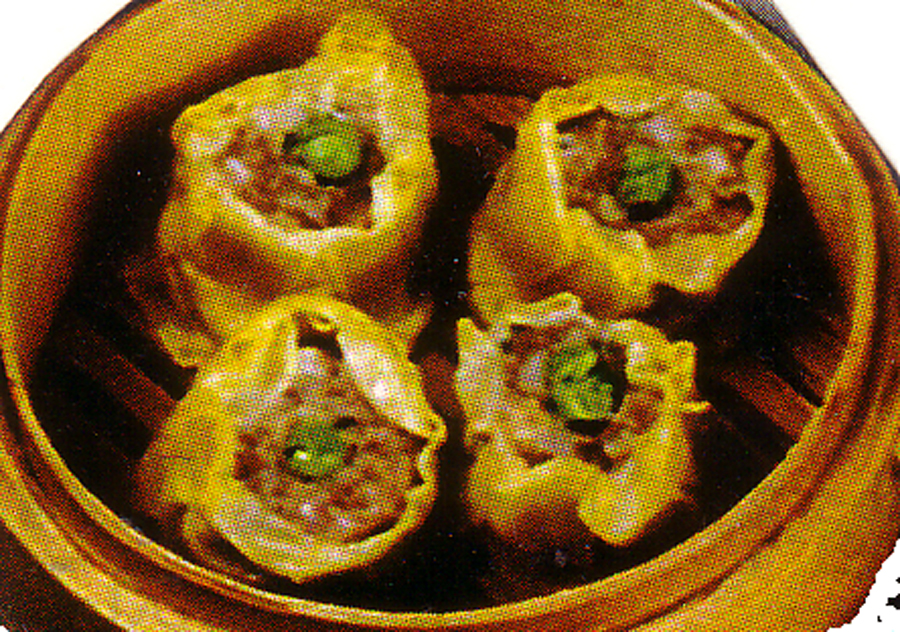 Modern takes on traditional dumplings can touch many a heart. May they never go out of style; and quite the contrary, may they be improved at every turn and twist of their dough. One letter to this editor asked about making a cocktail party using different Chinese dumplings and moon cakes and nothing else. Why not, we replied, and suggested they get ideas from our website and the Fall 1995 article by Wonona Chang.
Modern takes on traditional dumplings can touch many a heart. May they never go out of style; and quite the contrary, may they be improved at every turn and twist of their dough. One letter to this editor asked about making a cocktail party using different Chinese dumplings and moon cakes and nothing else. Why not, we replied, and suggested they get ideas from our website and the Fall 1995 article by Wonona Chang.
Never heard from them again. Still wonder what they learned and what they did, and how successful it was? Did they use items in volumes 2(3), 3(3), 4(3), and 5(1) as we recommended? Did they serve Moon Cakes, small or large? Did they cut them into pieces as Chinese people do, sharing them? We never had any with an alcoholic beverage, but who are we to say that they should not be so consumed.
Past issues have recipes for wrapped foods, some dumplings and some not. In the Winter 1995 issue, there was a recipe for Spring Rolls, a 'wrapped' notion. In the third issue of 1996, Taiwanese dumpling-type pastries could qualify. Check out the dozens of others in the past fifty-plus issues, a few gracing covers in or out of their steamer baskets. Many were not named a 'dumpling' but they really could be considered one.
One reader wrote he did not believe the Chinese had baked dumplings or other pastries. But King Wu of the State of Zhou, circa the 16th century BCE was honored by pastry chefs. They called him 'the father of their trade' and credit him with tai shi bing or baked flat cakes covered with sesame seeds. Some of these bing items come filled, some filled with sesame seed paste; are these not dumplings?
King Wu was given credit by these same pastry chefs for another bakery product, a honey cake called mier, known as zhang huang. There is a record of a mier made during the Spring and Autumn Period (770 - 476 BCE); was it filled? Chinese chefs can bake dumplings and other foods in their woks and metal can-like-ovens with and without fillings.
Many chefs concentrate on dough for dumpling exteriors, but these exteriors can and do vary. They can be made with wheat, rice, taro, or any other flour alone or mixed with another. The outsides or the interiors can be fresh or dried vegetables or various leaves, even meats. We have seen them with slices of pumpkin, eggplant, pepper, mushroom, or another vegetable on the outside or within. Some even are made with fruits outside or in, such as banana skins, fruit peel, sheets of bean curd, seaweed, or anything else you can think of. Recipes for different dumplings follow this article; they are, excuse the expression, the tip of the dumpling ice-berg whose very leaves can also be used as wrappings.
Dumpling fillings are more varied, and can be sweet, salty, savory, spicy, sour, or bitter. Dumplings can be as small as the ones we had in Suzhou or as large or even larger than the great ones we wrote about at VANESSA'S DUMPLINGS, at 220 East 14th Street, New York NY; phone: 212/529-1329. Speaking of Vanessa's; she recently re-vamped, expanded, and re-opened her place at 118A Eldridge Street between East Broadway and East Houston Street. Harley Spiller visited this 'old pro' at her newest place and wrote about it on pages 18 and 19 in this issue. We were there two days after that; folks were still waiting at her counter three deep. We adored her Pancake with Peking Duck and many of her other offerings. Vanessa is still making super and super-affordable dumplings in many locations. Wish we lived in New York City to enjoy them more often!
A question often asked is: Are dumplings really Chinese? A few argue that originally they came from Central Asia where they cook theirs on an iron grill. Others disagree and say there are no records that pre-date Chinese dumplings, and that the Chinese invented these dough-filled foods. A food historian would want a definitive answer, we just know that Chinese dumplings are delicious, and for hundreds if not thousands of years, large tea houses boast making and having made thousands of varieties. Few have less than a dozen, most brag they have fifty or more at any given time, and some adhere to ancient traditions and cook theirs on iron grills as pot-stickers.
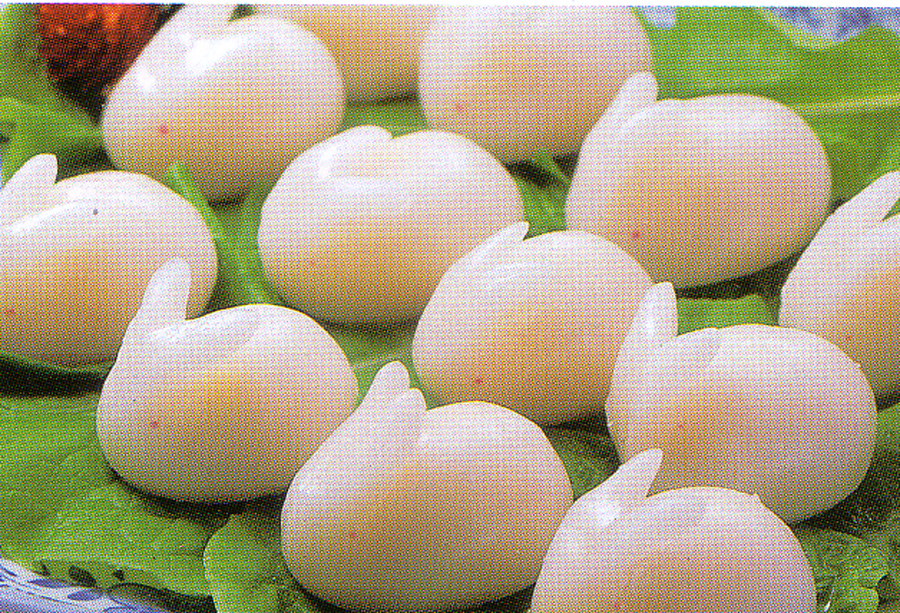 In China, an ancient dumpling emporium and restaurant, the PAN HSI at 151 Longjin Road West, in the Liwan District in Guangzhou; phone 8181-5955, still makes magnificent-looking dumplings. This multi-floored cavernous eatery makes beauties that look like and taste like heavenly fish and other animals.
In China, an ancient dumpling emporium and restaurant, the PAN HSI at 151 Longjin Road West, in the Liwan District in Guangzhou; phone 8181-5955, still makes magnificent-looking dumplings. This multi-floored cavernous eatery makes beauties that look like and taste like heavenly fish and other animals.
Restaurants in the United States such as YANK SING at 49 Stevenson Street in San Francosco CA 94105; phone: 415/957-7300 make gorgeous looking ones resembling animals and vegetables. Those looking like fish are illustrated on this page.
In New York City, CHINATOWN BRASSERIE at 380 Lafayette Street; phone: 212/533-7000, makes many dim sum delights. They have been illustrated in the New York Times and elsewhere, are gorgeous and delicate, one triangular-shaped looks like a modern fish, eyes looking at everyone who enjoys it.
Some dumpling eateries including ROLL AND DOUGH at 135 West 3rd Street also in Manhattan's New York NY 10012; phone 212/253-2890 make many bing, their large flat stuffed ones are akin to dumplings. They have an assortment, also soups to put them in, and a few dishes to accompany them. Their take-away menu is most helpful, its instructions are reprinted on this page to help you take care of your dumplings. It tells how to heat them in the microwave, steamer, etc. be they fresh, refrigerated, or frozen. Roll and Dough makes fourteen stuffed bing-pancake-like dumplings, the same number of different steamed or baked buns, ten different dumplings, and lots of soups, rice and noodle dishes, and fruit and vegetable drinks to go with them. They sell theirs fresh, refrigerated, and frozen.
When we ask dumpling makers about the origin of dumplings, every one says they originally were Chinese, and though every country can boast a dough-filled food or two, the Chinese have made them continuously for a few thousand years and perfected them. They also say that the Chinese have the largest selection of dumplings in the world. Perhaps they know this food item has been made and enjoyed in China at least since the first century BCE, or even before. They also advise how to make them.
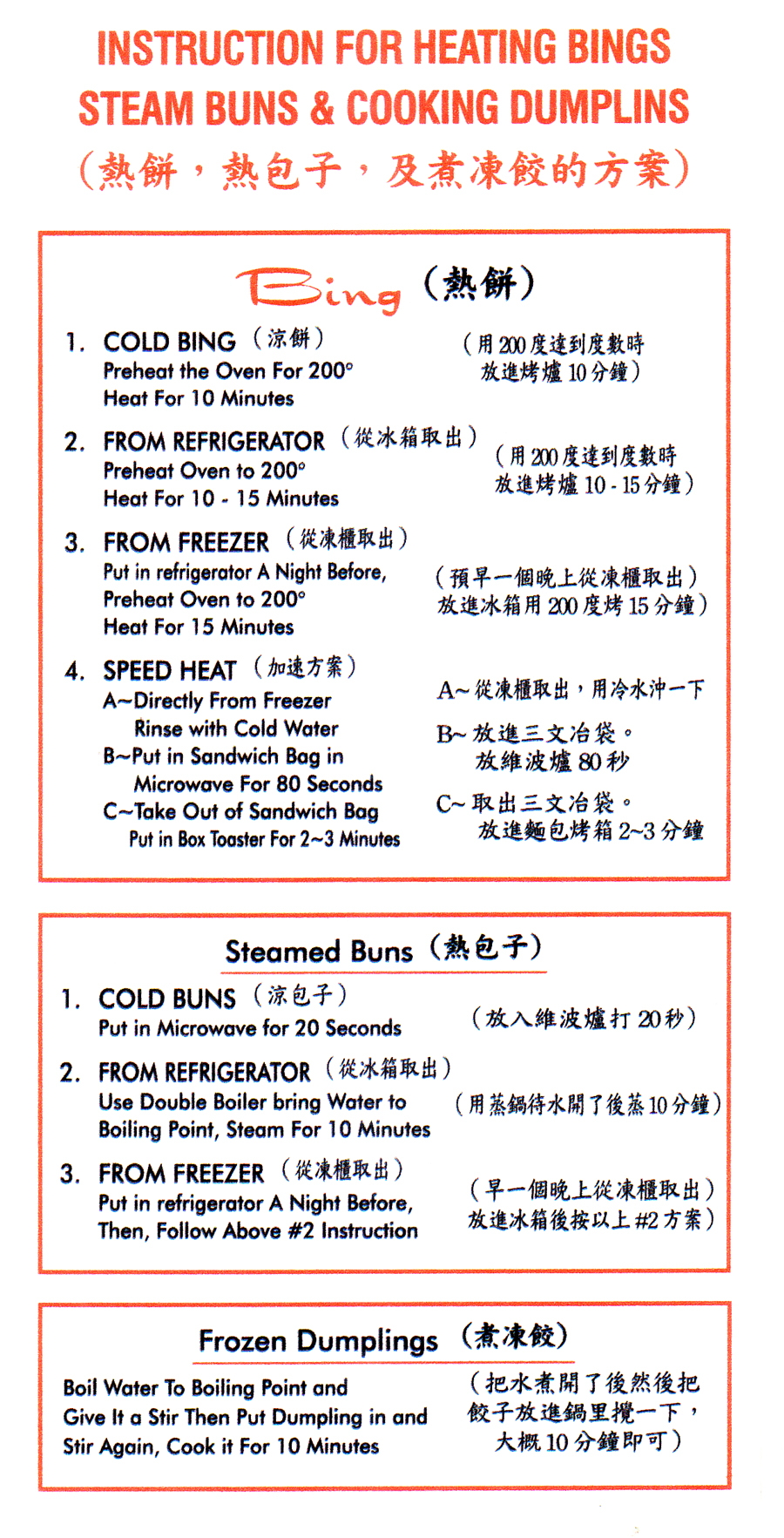 These very same dumpling makers remind us they were commonly called hun tons and that their shapes and fillings have changed over time. One said to tell readers that some are made with yeast, others only flour and water, some are less than delectable, and some are devastatingly delicious. They also said that some wrap theirs in dough made with lard, some include a mite of sugar, others put ground dry fish in their flour wrappings, and on and on.
These very same dumpling makers remind us they were commonly called hun tons and that their shapes and fillings have changed over time. One said to tell readers that some are made with yeast, others only flour and water, some are less than delectable, and some are devastatingly delicious. They also said that some wrap theirs in dough made with lard, some include a mite of sugar, others put ground dry fish in their flour wrappings, and on and on.
Dumplings are still evolving and probably always will. They can be filled with chicken, pork, lamb, any number of different meats, fish, and other foods of the sea, and/or with fruits and vegetables of every sort. Some have eggs within or without. Some are round, oval, circular, square, thick, thin, of any color imaginable, and any flavor one can dream of. If they have an outside and an inside, they like to call them dumplings, and these dumpling makers say that is all that is important.
Delightful, delicious, and different, designer or not, dumplings are great alone or in combination with other foods. Make or purchase them, serve or be served some, eat them in any number of ways and with any number of dips or dishes; simply delight in devouring them.
Some recipes follow to help you make your own. They are an assortment, each wrapped or filled differently. Do enjoy!
| Sui Mai |
|---|
1 package of round dumpling wrappers (about 50 to 60) 1 cup chopped cabbage 1 teaspoon salt 8 dried Chinese black mushrooms, soaked, stems discarded 1 pound finely chopped or ground fatty pork 1/4 pound fresh shrimp, skins and veins removed, the shrimp chopped 8 water chestnuts, chopped coarsely 2 Tablespoons thin soy sauce 1 Tablespoon sesame oil 1 Tablespoon Chinese rice wine, white or black 1 Tablespoon fresh ginger, minced 1 Tablespoon chicken broth or warm water 1 teaspoon granulated sugar 1 Tablespoon crab roe or 50 to 60 green peas, for decor 1 teaspoon oil, if using a metal steamer basket or small pieces of parchment paper, one for each siu mai dipping sauce of choice Preparation: 1. Unwrap the sui mai wrappers and cover with a damp cloth. 2. Mix cabbage and salt and let rest an hour, then squeeze well expelling and discarding any water. 3. Mince mushrooms and mix with the cabbage, shrimp, water chestnuts, soy sauce, sesame oil, rice wine, ginger, chicken broth or water, and the sugar. 4. Put one scant tablespoon of this cabbage-meat mixture on one dumpling wrapper and gather the wrapper around the meat, but do not close the dough; just flatten the meat in the open center part, and put a very small amount of crab roe or the green pea in the open center on top. 5. Either oil metal steamer basket or put each dumpling parchment paper about size of the dumpling itself. 6. Steam over rapidly boiling water for fifteen minutes, remove and serve alone or with any garlic dipping sauce, some hot oil, or duck sauce. |
| Har Gao II |
|---|
1 cup wheat starch, sifted twice or three times 1/2 cup tapioca flour 1 Tablespoon peanut oil 1 pound shrimp, shell and veins removed, shrimp coarsely chopped 1 egg white 4 water chestnuts, coarsely chopped 1 scallion, white part only, minced 1 Tablespoon thin soy sauce 1 Tablespoon white Chinese rice wine 1 Tablespoons vegetable oil 1 teaspoon tapioca flour 1 teaspoon salt 1/8 teaspoon ground white pepper Preparation: 1. Sift wheat starch and tapioca flour, then add one cup very hot water and the peanut oil and stir and stir until it starts to cool. Next, start to knead until this dough is smooth and soft. Roll half of it into a one-inch cigar-shaped piece, cut it into one-inch pieces and cover them. Repeat with the other half of the dough, always covering the dough or the pieces of dough when not working it. 2. Roll each piece of dough into a three inch circle. Keep them covered after they are rolled out. 3. Mix shrimp, egg white, water chestnuts, and the scallion white parts. Then add soy sauce, rice wine, tapioca flour, and the salt and pepper, and mix gently. 3. Brush the dough circle with a mite of vegetable oil, and put a heaping tablespoon of the filling on this. Fold in half and pleat the edges. Continue until all are filled. Use any remaining oil to brush on the steamer basket, set har gao on it, none touching another. Cover and steam them over hot water brought to the boil, then boiled for four minutes. Serve. |
| Tofu-wrapped Fish Dumplings |
|---|
1/2 pound flounder and another white fish, coarsely chopped together 1/2 teaspoon salt 1/2 teaspoon granulated sugar 1 teaspoon Chinese white rice wine 1/8 teaspoon ground white pepper 8 pieces tofu skin, each three-inches square 1 egg yolk 1 cup vegetable oil dash ground Sichuan pepper mixed with teaspoon salt Preparation: 1. Gently mix fish, salt, sugar, and ground white pepper. 2. Brush egg yolk on the edges of the tofu pieces, and put one heaping tablespoon of the fish mixture on each one. Roll as you would an egg roll, folding in the sides. Put each tofu roll on a plate seam-side down. 3. Heat vegetable oil, and fry half the fish dumplings on one side until golden, turn over and fry the other side. Then remove to a paper towel, and cover lightly with another paper towel. Repeat until all are fried, then serve. |
| Seaweed-wrapped Dumplings |
|---|
1/2 pound shrimp, shell and veins removed, shrimp coarsely chopped 1/4 pound ground fatty pork 1 egg white 1 Tablespoon minced peeled fresh ginger 1 Tablespoon Chinese rice wine 1 teaspoon cornstarch 1 scallion, green part only, minced coarsely 5 sheets purple of black laver, soaked in cold water for two minutes 1 cup vegetable oil Preparation: 1. Mix shrimp, pork, egg white, ginger, rice wine, cornstarch, and scallion pieces. 2. Take one seaweed sheet of laver, and put one-fifth of the shrimp mixture on it, and roll as if rolling an egg-roll, turning in the side. Put on a platter, seam side down, and repeat until all five sheets of seaweed are rolled. 3. Heat oil in a wok or fry pan and put laver dumpling rolls in, seam side down, and fry about four minutes or until crisp. Turn over and fry on their other side. Drain on paper towels, cut each in half, on an angle, and serve. |
| Black and White Rice-wrapped Dumplings |
|---|
1/2 cup glutinous rice, soaked in warm water for two hours, then drained, and paper-towel dried 8 black Chinese mushrooms, soaked and stems removed and discarded 8 water chestnuts, minced 1/2 pound ground pork 1/4 pound shrimp, peel and veins removed, and chopped 1 scallion, minced 1 Tablespoon thin soy sauce 1 teaspoon salt 1/2 teaspoon sugar 1 Tablespoon cornstarch 1 Tablespoon vegetable oil Preparation: 1. Mix rice with half the minced black mushrooms and half the water chestnuts with the rice, and set aside on paper towels to dry for another hour. 2. Mix remaining minced mushrooms and water chestnuts with the ground pork and minced shrimp,, the minced scallion, and the soy sauce, salt, sugar, and cornstarch. Take two tablespoons of this mixture and roll into a ball; then roll that into the dried rice mixture. Be sure the rice mixture is rolled tightly around the meat mixture. 3. Oil a steamer basket and put the rice balls on it, each separated from the others; and steam over rapidly boiling water for half an hour. Then remove and serve. |
| Eggplant Dumplings |
|---|
2 Tablespoons dried shrimp, soaked, then minced 5 Tablespoons ground pork 2 scallions, minced 1 Tablespoon cornstarch 1 Tablespoon thin soy sauce 1 Tablespoon white Chinese rice wine 1 eggplant, thinly sliced 1 egg yolk 1 cup vegetable oil Preparation: 1. Mix minced dried shrimp, ground pork, scallions, cornstarch, soy sauce, and the rice wine. 2. Take two slices of eggplant and put them crossing one another; then put two tablespoons of the pork mixture on the part where the eggplant slices cross. 3. Beat the yolk with two teaspoons of water and brush this on all exposed surfaces of the eggplant before folding them over the meat mixture. The eggplant mixture in the eggplant should look like a box, sitting on its loose or open ends. Continue until all box-like dumplings are made. 4. Heat oil in a wok or fry pan and fry half of the dumpling boxes about three minutes per side until they are golden and crisp. Repeat until all are fried, then cut each one on an angle, line them up on a fried end, and serve. |
| Banana Dumplings |
|---|
4 large nearly but not ripe bananas 1 Tablespoon cornstarch 6 Tablespoons canned or freshly made sweet bean paste 1/2 cup wheat or all-purpose flour 1 teaspoon baking powder 1/2 teaspoon baking soda 1 teaspoon brown sugar 1 cup vegetable oil 1/4 cup powdered sugar Preparation: 1. Peel, then cut the banana in half, lengthwise; and keep both halves together. Reserve one long thin strip less than a quarter of an inch from each peel. Sprinkle cornstarch on their cut sides. 2. Divide the bean paste in four parts, and spread each part on one of the two banana halves, then sandwich then together, being careful not to break the banana halves. Cut each filled banana into four or five sections. Tie each section with one strip of the banana peel leaving the ends sticking out. 3. Mix flour, baking powder, baking soda, and brown sugar, then add half cup of water to make a thick batter. 4. Heat oil, dip half the banana sections in the batter, drain, and fry them in the oil until crisp, stirring once or twice after two or three minutes in the oil. Then drain on paper towels. Repeat with the other half of the banana sections. 5. Put banana sections on a serving platter, then put the powdered sugar in a fine strainer, and sprinkle some on the banana sections. Serve, and remind those eating them not to eat the banana skins. |
| Beef Dumplings |
|---|
2 and 1/2 cups flour 1 pound hand-mince d or coarsely ground beef 1/3 teaspoon salt 2 Tablespoons mushroom soy sauce 1 teaspoon sesame oil 1 scallion, minced 1 egg white mixed with one tablespoon of water 2 teaspoons sesame seeds, black, white, or mixed 2 Tablespoons vegetable oil Preparation: 1. Put flour in a bowl, add half cup of boiling water, and stir until combined, then slowly add half cup of cold water and keep stirring until the dough makes a ball. Then knead for five minutes until dough is smooth and shiny. Cover and allow to rest for half an hour, then divide into eight parts and let rest another fifteen minutes. 2. Mix beef, salt, soy sauce, sesame oil, and the minced scallion until combined. Divide into eight parts. 3. Roll the rested dough into circles, thinner on the outside than the center, about five to six inches in diameter. 4. Brush each piece of dough with egg white and fill each of them centering one batch of meat in its center and gathering the thin edges of the dough over each other making a pancake-type dumpling. Be sure the egg white seals the dough on all overlapping pieces. Put sealed side down on a platter. And brush the top of each one with some egg white, then sprinkle sesame seeds on it and press them into the dough. 5. Heat oil and fry half the dumpling patties, sesame seed side down, on one side for two or three minutes or until brown, turn over and fry them on the other side until brown. Remove and drain on paper towels. Repeat with the second batch. Serve alone or with a sauce of your choice. |
| Shrimp-rolled Dumplings |
|---|
3 cloves garlic, peeled, and finely minced 1 scallion, finely minced 1/2 pound minced or ground pork 1 teaspoon ground white pepper 1 teaspoon tapioca flour or potato starch 1 Tablespoon of all-purpose flour 1/4 cup dried small shrimp, coarsely minced 1 egg, beaten with one Tablespoon of water 1 cup vegetable oil Preparation: 1. Mix minced garlic, scallion, pork, white pepper, tapioca flour, and the all-purpose flour. Make this meat mixture into twenty balls. 2. Roll the balls into the beaten egg, then into the minced dried shrimp, lightly press the shrimp into the meat mixture, and set them aside to dry for fifteen to twenty minutes. 3. Heat oil, and put meat balls into the oil and fry, stirring after one minute, until they are golden brown (about two or three minutes). Drain on paper towels, then serve. |
| Almond Pumpkin Dumplings |
|---|
1 pound diced pumpkin, boiled until soft, then drained and mashed 1 cup glutinous rice flour 2 Tablespoons vegetable oil 1/2 pound ground pork 2 Tablespoons minced dried shrimp, minced 2 Tablespoons minced Chinese radish 3 Chinese black mushrooms, soaked, their stems removed 1/4 teaspoon salt 1 teaspoon sugar 1 teaspoon sesame oil 1 Tablespoon cornstarch and one tablespoon of cold water 2 Tablespoons sliced peeled almonds 2 Tablespoons peanut oil Preparation: 1. Mix mashed pumpkin, glutinous rice flour, and half the vegetable oil. Set aside to cool. 2. Heat the rest of the oil, fry the pork, shrimp, radish, mushrooms, salt, and sugar for two minutes. Set aside in a strainer sitting over a bowl, until cool. 3. Take three tablespoons of the pumpkin mixture and make it into a ball. Push a thumb into the center and make this into a large opening. Stuff with three tablespoons of the meat mixture, and push the ends of the pumpkin up and around sealing the meat inside. Set aside on a platter brushed with some of the sesame oil. Repeat until all the pumpkin and meat have been used. 4. Brush the rest of the oil onto the bottom of a steamer basket and onto all of the pumpkin dumpling balls. Brush the cornstarch mixture over this and sprinkle some almond slices on the top of each ball, slightly flattening it while pushing the almonds slightly into the pumpkin dough exterior. Use leftover cornstarch water brushing the tops of every dumpling. 5. Steam over rapidly boiling water for five minutes. 6. Heat peanut oil, and remove pumpkin dumplings to the hot oil, and fry about one minute or two until their bottoms are golden. Turn them onto their tops and fry another minute. Drain on paper towels, then serve. |

Copyright © 1994-2025 by ISACC, all rights reserved
Address
3 Jefferson Ferry Drive
S. Setauket NY 11720